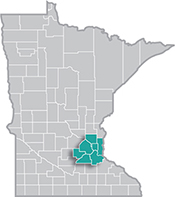 The Minneapolis-St. Paul metropolitan area is a national leader in finance, advanced manufacturing, agriculture and retailing.
The Minneapolis-St. Paul metropolitan area is a national leader in finance, advanced manufacturing, agriculture and retailing.
Medical devices, electronics and processed foods are strong suits recognized globally.
Want the freshest data delivered by email? Subscribe to our regional newsletters.
8/20/2024 12:48:28 PM
Tim O'Neill
Last month, we investigated the Twin Cities Metro Area's labor force trends. To recap, the region's labor force size and makeup is shifting dramatically. With changing labor force trends, resulting in increasingly tight labor market conditions, the case for analyzing all demographic shifts has become ever more important. How quickly are populations of color growing in the region? Is the labor force still aging? How is labor force participation trending for teenagers? How about for young adults? Are those with disabilities witnessing improved employment opportunities? Are employers hiring those who have criminal backgrounds and are looking for a chance to get back to work and make a new living? How are job requirements changing in relation to educational attainment and skill sets?
And these questions are just scratching the surface of those related to how the labor market is doing, and how workforce development is shaped to assist all of those living and working in Minnesota in general and the Twin Cities Metro Area in particular.
Let's take just one of these questions as an example: how is labor force participation trending for teenagers? According to data from the U.S. Census Bureau's American Community Survey (ACS), there were nearly 80,000 teenagers aged 16-19 years in the Metro Area's labor force in 2022. At the time, this group had a labor force participation rate of 50.3% and an unemployment rate of 11.8%. This compares to a labor force participation rate of 71.0% and an unemployment rate of 4.0% for the region's total labor force. Lower labor force participation for teenagers isn't a new trend, and their unemployment rates are historically higher as well. However, with improvements to those indicators for teenagers over time, that will help to alleviate tight labor market conditions in the region, and assist teenagers with work experience today and career pathways down the road.
| Table 1. Labor Force Conditions for Teenagers in the Metro Area, 2022 | ||
|---|---|---|
| Status | Labor Force, 16 to 19 Years | Total Labor Force |
| In Labor Force | 79,234 | 1,778,729 |
| Labor Force Participation Rate | 50.3% | 71.0% |
| Unemployment Rate | 11.8% | 4.0% |
| Share of Total Labor Force | 4.5% | 100.0% |
| Source: U.S. Census Bureau, American Community Survey 5-Year Estimates | ||
Analyzing labor force and employment trends for teenagers isn't new. For example, recent analysis highlights how teenage employment jumps during the summer months as many teenagers move into full employment after finishing their education or look for temporary work for the season. This analysis also highlights how teenagers have higher shares of employment in Accommodation & Food Services; Arts, Entertainment, & Recreation; and Retail Trade, industries that typically don't require higher levels of postsecondary education or years of experience.
Workforce development aimed towards teenagers and young adults isn't new either. Staff at CareerForce locations are able to assist teenagers and young adults with everything from career exploration to job search skills to determining eligibility for employment and training programs just for young people. One such program is the Minnesota Youth Program, which provides short-term employment and training services to low income and at-risk youth.. School districts have staff to help students find work while they are in school and gain work experience that can help them find a career path. For example, the Youth Skills Training Program promotes greater collaboration between schools, employers, and community organizations to help teenagers build work experience and to help employers fill workforce gaps.
Workforce Development Boards in the Twin Cities Metro, which are part of the statewide CareerForce system, include: the Anoka County Workforce Board, Dakota-Scott Workforce Development Board, Hennepin-Carver Workforce Development Board, Minneapolis Workforce Development Board, Ramsey County Workforce Development Board and the Washington County Workforce Board. As part of the statewide CareerForce system, staff from these workforce development organizations, along with staff from the Minnesota Department of Employment and Economic Development and community partners serve tens of thousands of job seekers and employers every year across the Twin Cities.
DEED's Workforce Strategy Consultants assist employers with creating strategies and policies for hiring and retaining a younger workforce. And, of course, there's plenty of data and labor market tools to assist teenagers with learning more about work opportunities out there and how to improve their chances in securing that work, such as:
With the labor market shifting in the Metro Area and Minnesota, it's important to understand how these changes are impacting all populations, and how all stakeholders, including career seekers, employers, schools and educators, local and state governments, economic development agencies, nonprofits and more can be a part of workforce development to make it as efficient and equitable as possible.
Contact Tim O'Neill, Labor Market Analyst, at timothy.oneill@state.mn.us.